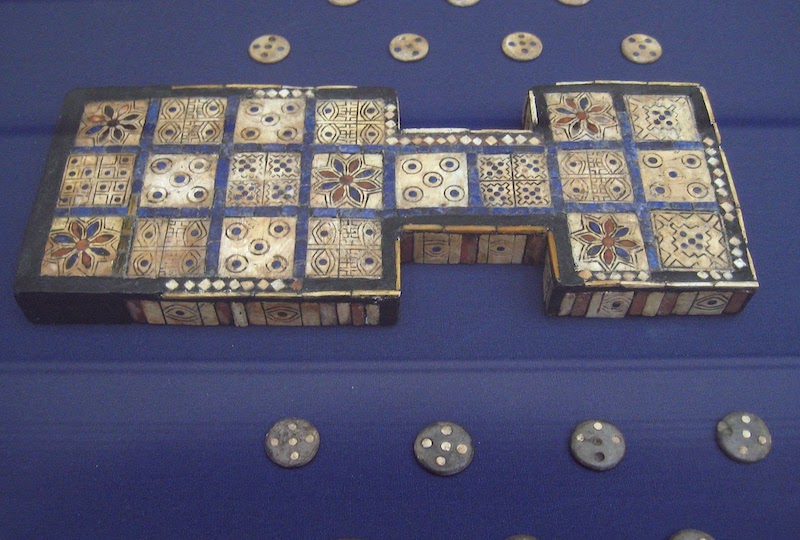
I don’t know about you, but for me, there’s nothing quite like a nice board game after a long day at work. There’s something about it: the bright colors, the simple rules, the nostalgia of remembering playing board games with my sister as kids, lying on the living room carpet and accusing each other of cheating. Playing board games relaxes me, taking me out of my head and transporting me to a different world.
You might have had a similar experience. Board games are popular for a reason. In fact, they’ve been popular for a very long time. Board games are one of humanity’s earliest pastimes, arising independently in civilizations all over the globe. In this article, we’ll explore a few of those ancient board games, analyzing their origins, their game rules, and how they eventually developed into the games we know and love today.
The World’s Oldest Board Game
The Royal Game of Ur
The world’s oldest board game is called The Royal Game of Ur. This game dates back as far as 4,600 years ago to Ancient Mesopotamia. Unlike many other ancient board games, we actually know the rules to the Royal Game of Ur: it is a race game in which players compete to travel across a simple but unique board. Composed of one 3×4 square section and one 2×3 square section, the two major sections are connected by a “bridge” of two squares.
Curator Irving Finkel was the first historian to translate the rules of the game. You can watch him playing the game below.
Other Ancient Board Games
Senet
Another ancient board game is Senet. This Egyptian board game dates back to 3100 B.C. and is similar to both Backgammon and the Royal Game of Ur, seeing players racing to the end of the board. Players threw casting sticks or bones to determine how far they could move on each turn. Early versions of the board were very simple, composed of 30 squares. However, over the years, the game evolved, and special squares were added to the board. But changes to the game certainly didn’t dilute its popularity: Senet was a very well-liked game in its time, favored by famous figures such as Queen Nefertari and King Tut.
Mehen
Mehen, another Egyptian game, was played around 5,000 years ago. It has a uniquely stunning board: designed to resemble a snake, more ornamental versions of these boards look fit to decorate a bedroom wall. Like Senet and The Royal Game of Ur, Mehen was a race game in which players competed to race from to the center of the board and back. But the exact mechanism of play aren’t known. Pieces found associated with Mehen boards, including player markers and lion-shaped figurines, seem too small to fit on the individual squares of Mehen boards, raising the question of whether gameplay was more complex than we might imagine.
Tafl
Also called Hnefatafl, or ‘King’s Table’, this Viking game posed different challenges for opposing players. As in chess, the game calls for two opposing players: however, rather than facing off at opposite ends of the board, the one begins in the center, circled by the opposing player’s pieces at all sides. The first player’s goal in the game is to get their king off the board. This game was likely created around 400 B.C. and remained popular for many years throughout Western Europe, partly due to ongoing Viking raids and the subsequent maintenance of Viking influence in the region.
Go
Many of these ancient games have long fallen out of favor. One which hasn’t is Go, which originated in China around 3,000 years ago. Go is a strategic game in which players compete to hold the most area on the board. In service of this goal, they place pieces and capture enemy tokens. Go was popular for many years in China before eventually crossing the ocean to Japan in around 500 A.D. Later, in the twentieth century, Americans picked up the game during their occupation of the Japanese islands.
Chess
One of the oldest games in the world remains one of the most popular. Chess, the best-selling game of all time, originated in India around the 8th century A.D. Originally called Chaturanga, the first version of the game featured pieces which moved like modern chess pieces across the board. However, Chaturanga was also a luck-based game, since players had to throw sticks to determine how pieces could move. The subsequent introduction of Chaturanga to the Sasanian Empire and then Arabic regions eventually allowed chess to develop into its modern form. Arabic armies introduced the game to Europe, and by the 1300s had become popular across Western Europe.
The Development of Modern Games
The First Commercial Game: Game of the Goose
After thousands of years of steady gameplay, the first commercially produced board game was created in the 16th century. Called Game of the Goose, or Gioco dell’Oca, this game was created as a gift from Duke Francesco de Medici to Phillip II of Spain. Unlike many other board games, Game of the Goose is solely a game of chance, with no skill involved whatsoever. Players follow the spiral path of the board to the center, throwing dice to determine how far they can move. Sound fun? Europeans thought so. Within a few decades of Francesco de Medici’s gift, the game had proliferated across Europe, with versions popping up in France, Italy, and Germany.
Monopoly & Others
Monopoly is a classic board game with political origins. Created by Elizabeth “Lizzie” Magie in 1903, the game was originally intended to demonstrate her reasons for supporting the abolishment of all taxes except for land taxes. This was considered a progressive policy, since it was supposed to close the wealth gap. But unfortunately for Magie, the original Monopoly game, called The Landlord’s Game, never really found its audience. For years it was played only occasionally, usually in revised forms, by small groups.
Later, popular game creators decided to buy and publish one of these spin-offs. But it was one of the less political versions of Magie’s game, meaning the original, progressive Monopoly board was never widely played.
Board Games in the Future
In the centuries since The Royal Game of Ur was created, humans have found a lot of other things to do with our time: card games, novels, movies, and, most recently, video games are all great ways we while away our days. But though the board game market flagged in the late nineties, it’s recently bounced back. Board game sales increased around 25 to 40% annually from 2011-2014, and the internet has provided a new medium in which to play classic games. Online versions of chess and backgammon, among others, allow for gameplay across far greater distances than ever before imagined.
Ultimately, these new technologies don’t provide competition for board games but new opportunities, leaving the question open as to how board games might evolve moving forward. Who knows: maybe, in a hundred years, board games will be as different from Monopoly and the Settlers of Catan as they are different from the Royal Game of Ur.


